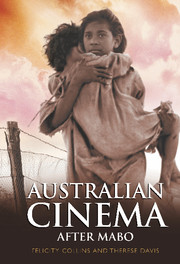Book contents
- Frontmatter
- Contents
- Acknowledgments
- Part 1 Australian Cinema and the History Wars
- 1 Backtracking after Mabo
- 2 Home and Abroad in Moulin Rouge, The Dish and Lantana
- 3 Elites and Battlers in Australian Rules and Walking on Water
- 4 Mediating Memory in Mabo – Life of an Island Man
- Part 2 Landscape and Belonging after Mabo
- Part 3 Trauma, Grief and Coming of Age
- Bibliography
- Index
3 - Elites and Battlers in Australian Rules and Walking on Water
Published online by Cambridge University Press: 31 January 2011
- Frontmatter
- Contents
- Acknowledgments
- Part 1 Australian Cinema and the History Wars
- 1 Backtracking after Mabo
- 2 Home and Abroad in Moulin Rouge, The Dish and Lantana
- 3 Elites and Battlers in Australian Rules and Walking on Water
- 4 Mediating Memory in Mabo – Life of an Island Man
- Part 2 Landscape and Belonging after Mabo
- Part 3 Trauma, Grief and Coming of Age
- Bibliography
- Index
Summary
Australian cinema, perceived as an international genre, brings to mind iconic landscapes, characters and stories which take hold in the memory as visual images. However, in Australian Rules (Paul Goldman, 2002) and Walking on Water (Tony Ayres, 2002), it is the voice and the breath that linger in the memory as aural images. In Australian Rules there is a transformation from a polyglot of vernaculars in the opening sound sequence to one clear voice-over at the end. In Walking on Water, everything important hinges on the breath, from Gavin's last strangled gasp to the breakdown and recovery of each of the characters involved in Gavin's final expiration. This chapter will explore the loss of identity and recovery of the voice, and the breath, in Australian Rules and Walking on Water. Between them, the two films draw our attention to the reshaping of a transplanted Anglo-Celtic social imaginary in Australian cinema. Miriam Dixson argues that ‘Australian identity still carries the marks of yesterday's British connection’. David Malouf qualifies that assertion by arguing that an experimental and open sense of identity characterises the Australian social imaginary because ‘we are a bit of the motherland set down in a new place and left to develop as the new conditions demanded, as climate, a different mixture of people, changes in the world around us, and our reaction to them, determined’.
- Type
- Chapter
- Information
- Australian Cinema After Mabo , pp. 41 - 58Publisher: Cambridge University PressPrint publication year: 2004

